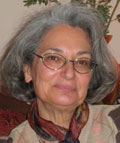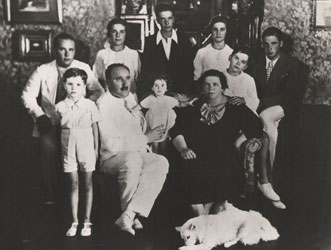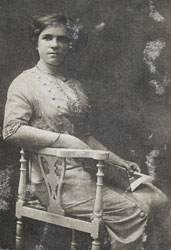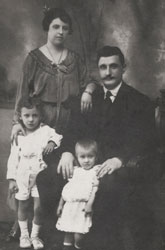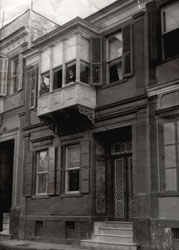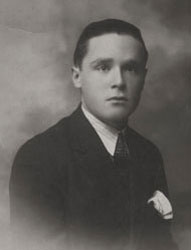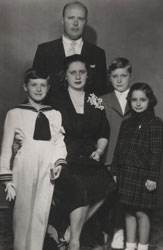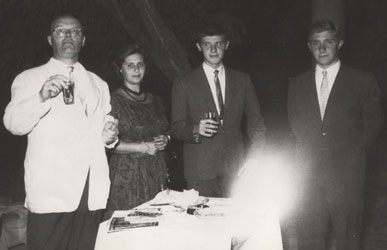Interview with Anna Maria and Rinaldo Russo conducted by Görkem Daşkan in Bornova, Izmir on January 8, 20121
On Whom They Are and Their Ancestors
Anna Maria Russo: I was born on 25 August 1948 in Alsancak, Izmir. I lived in Alsancak for all my life, except for the 6 years I had to spend in Istanbul because of work. My childhood and youth, I spent in Alsancak. I was born at my maternal grandmother Marie Russo’s family house which was located across from Alsancak Police Station and pulled down in 1970. As kids, Rinaldo and I grew up in that house and until the early years of my marriage I kept living there. My parents moved to Gül Sokak2 in 1971.
Rinaldo Russo: I was also born in Izmir, in 1946. My father Edmond3 and Anna Maria’s mother Eliana4 were brother and sister. Our grandparents (that is Edmond and Eliana’s parents) were called Marcel5 and Marie (née Maggiar) Russo6. They had 8 children together: Edmond, Jean, Charles, Gabriella, Eliana, René, Pierre and Maria Paula. There was an Ernest who was born in 1917 but died when he was still a baby. Grandfather Marcel had 5 siblings: Abel7, Gabriel, Marthe, Marie-Jeanne and Elyse. My mother was called Filomena (née Cosentino)8. My maternal grandfather was called Giuseppe Cosentino. They were all born and passed away in Izmir. Our great grandparents (that is Marcel, Abel and et al’s parents) were also called Edmond and Maria (née Russo) and born in Izmir. The two were relatives, cousins virtually. Great grandfather Edmond’s parents were called Tommaso and Elena (née Say or Sary) Russo, and great grandmother Maria’s grandparents were called Sophie (née Ballin) and Michele Russo. We know very little about the Ballin family. They came from Vendée in France, as far as we know, escaping the war that took place there at the time.
Anna Maria: That is a tradition in our family: Babies are given their forebears’ names and this has lasted for generations. This situation became an obstacle for us while tracing our ancestors. Anyway, there must have been another Tommaso Russo who lived in Izmir before the Tommaso who was the father of our great grandfather Edmond. There was also a Cristoforo, I think. I have an aunt living in Italy who was born in 1922, and from what she has remembered and told me once, something she has heard from her father (our grandfather) Marcel actually; the first Russos to settle in Izmir around 1810 were three brothers from Florence who were tailors. We understand that there were more than one branch of the Russo family in Izmir, and as predecessors of one of them; we are currently trying to figure out whether there was any kinship between those branches. There is a mansion at Buca, for instance, known to be the Russo mansion, however not related to us; and that was obviously owned by one of the other branches of the Russo family. That branch, I think, did not live in Izmir too long, and at some point returned to where they now live: Italy. As already stated, my mother Eliana and Rinaldo’s father Edmond were 8 siblings. We are only three Russos living in Turkey as descendants of the Marcel branch of the family: Rinaldo, his older brother Alfio who lives in Istanbul and me. After a generation of tailors, during the reign of Edmond, the Russo family got into the export business – the export of raisins, dried figs and the like. Grandfather Marcel and his brother Abel Russo were traders. Marcel had worked at the Girauds’ dried fruits business for a while, and then since Marcel’s wife Marie’s (née Maggiar) maternal uncle Ernest Magnifico had a connection with a trade establishment of the Abbott family9, he later got involved in the management of that company. This company [view advert of the time] operated the emery mines at Güllük and exported the product. Marie was to inherit her uncle’s enterprise and so her husband took control of it together with Mr Abbott10. Grandfather Marcel passed away in 1970 and Mr Abbott before him. The company managed to operate until the 1960s; however, the work scope and scale had already reduced by then. Grandfather had become paralysed on one side11 in the late 1950s. Being based in Izmir, he travelled back and forth to Güllük for work, before his health problems arose that was going to affect the productivity of the firm negatively. He used to travel often to the US and other countries especially in the 1940s and 50s, and that also had come to a halt after he got sick. The company was sold to a businessman from Milas called Ludullah Kitapçı after my grandfather’s demise. I don’t know whether the firm still functions today. The company’s Izmir office used to be at the Rees office block at Pasaport.
Rinaldo: I had worked at the Rees block for a while. For 4 or 5 years I worked at a ship agency found in that block. My father also worked at the same building for another ship agency owned by an Englishman. He left that firm after World War II and found another job at Mücahit Büktaş’s company. That company was specialised in the trade of licorice. At the time that he died, he was working there. Before I found this job at the Rees block, I had worked for a while at a fig enterprise owned by Nuri Soyluer and directed by an Izmir Jew, who happened to be my boss, the late Rafael Sidi. After that, I worked for seven years at the Banca Commerciale Italiana. Following that, for another seven years I worked for a company called Kadıoğlu, specialising in the trade of dried fruits. I retired around 1995 during an economic crisis that affected my last working place very badly. To cut a long story short, I followed my grandfather’s footsteps working at various export trading companies.
Top from left to right: Edmondo, Gabriella, Carlo, Eliana, Renato, Giovanni Bottom from left to right: Pietro, Marcello Russo, Maria Paola, Marie (née Maggiar) Russo and Jipps. Russo House in Punta, around 1935. |
Marie (née Maggiar) Russo, Smyrna, 1900-10. |
Clockwise from left: Pol (Rinaldo Russo’s uncle), Evanthia (née Epenetou) Cosentino (Mr. Russo’s maternal grandmother), Giuseppe Cosentino (Mr. Russo’s maternal grandfather) and Filomena (Mr. Russo’s mother). |
On the Levantines of Izmir and the Question of Being a Levantine
Anna Maria: On Kıbrıs Şehitleri thoroughfare12, Gibert Corinthio used to run a toy shop (he had a daughter called Gloriana), Felice Capadona and Ivan Missich both had clothes boutiques. The florist Schlosser and the pharmacist Costa -Costa was Greek, I suppose- also had their shops there. There was the Paradiso Bakery and Mrs. Consolo’s Bakery on the branch street to Kıbrıs Şehitleri where there now stands the Tömer language school building. There was a hardware shop in the area owned by Giuseppe Chiarenza who used to also build small houses. Mr Chiarenza may not be considered fully a Levantine as he was from Sicily and the first in his family to settle in Izmir; he didn’t have much of a past in this city.
The neighbours of Rinaldo on 1462 Street, where he grew up, were the Simes, Penso, Sera, Papi, Toctan and Bertuzzi families. A Jewish violin teacher, Marta Amati, used to live on the same street. Mr Penso was a jeweller. Then there was Henry Blackburn and his sister Odeille: they used to run a bookstore, Hachette, on the corner across from the Gazi Elementary School on Talat Pasha Boulevard which is an optician’s shop at present. He used to also give French lessons, which Rinaldo and I took for a while. There were Angele Papagno and her mother who used to live together. They were probably of Italian descent. There were Turkish families as well: Doctor Hulki Cura, for instance, who was a famous otorhinolaryngologist, and then Recep Kocatepe whose occupation was to give injections, Adil Gürkaynak and Aziz, another giver of injections who used to work at Costa’s pharmacy. The 1462 Street was not the only street in the area where Levantine families largely lived. Kıbrıs Şehitleri, Bornova Street and the 1442 Streets were also inhabited by Levantines. I remember there was a house on Bornova Street where a few Micaleffs lived: Lizzy, Lucie, Joyce and Irma Micaleff13. Another resident of the street were the Tornavitis.
Rinaldo: There were the Bionis whose house was opposite the former Şölen film theatre. The family had two children: Paulino and Yvonne. Mr Paulino still lives in Izmir. Yvonne has been living in the USA for long time.
Anna Maria: Yes, they used to live on Mahmut Esat Bozkurt Street. Many Levantines lived there. Rudolf Korn and his family also lived there; the Delpinos, too.
Rinaldo: And Charles Toctan.
Anna Maria: They had moved there later. The Korns were of German descent. Rudolf Korn’s late wife was a relative of George Galdies, an Izmir Levantine now living in the UK.
Rinaldo: There was a bookstore next to Izmir Sinemasi (Izmir film theatre), a Hachette franchise, owned by Oscar Stano. Oscar used to work at Visentini’s bookstore –an Italian Levantine but I can’t remember his full name, maybe Paul– where they used to sell mostly foreign magazines. The store was at Pasaport, towards Konak. After working there for some time, Oscar had opened his store near the film theatre. This was in the 60s and early 70s.
Anna Maria: The business district centre used to be Pasaport in those days, for the former port centre was situated there. Also, historically, that was the han14 area that has seen a tremendous change over the years. Many of those hans got torn down after the port was moved northwards; only a few of them remained untouched. The Rees Han was one of them. The building was restored and is still in use at present. My generation was able to witness the changes in Izmir this much, and I don’t know much about the old Izmir really. There must have been so many clubs, hotels, theatre and film venues on the Cordon before the fire destroyed them, but I unfortunately cannot give any names.
I call myself an Izmirian of Italian origin. The Levantines of Izmir have for centuries made intra-community marriages as well as with non-Muslim natives of the city. Rinaldo’s father and uncle, for instance, had married Christian locals. So did my uncles and aunts. One of them, however, married a Belgian and the other one, an Italian. He had gone to Italy for military service and decided to stay there after getting married there. This is a contemporary Levantine thing, leaving Turkey. My uncle, whose wife was a Belgian, lived ever since he married his wife in Belgium, worked at the then European Economic Community and passed away there. My oldest aunt was working at a company owned by the Pagys in Izmir when he met an Italian shipmaster and moved to the Italian island of Procida after getting married to him.
Russo/Cosentino House in Alsancak in the 1930s. |
Edmondo Russo, Izmir, 1940s. |
Top: Edmondo Russo Bottom from left: Rinaldo, Filomena and Alfio Russo, and Anne-Marie (née Russo) Erem, 1960s. |
From left to right: Edmondo, Filomena, Rinaldo and Alfio Russo, Izmir, 1950s. |
Anna Maria’s Bank Career
I attended the Italian school in Izmir. I worked for 40 years at the Banca di Roma [view of building pre-1922, Republican era location, archive view of its stand in the Izmir International Fair Site], roughly between 1967 and May 2008. Just for 14 months in this period I worked at Arkas Holding. After the Izmir branch of Banca di Roma was closed, I went to Istanbul to work at the Istanbul branch and for 6-6.5 years I lived there. Banca di Roma used to have only two branches in Turkey: in Izmir and Istanbul. In those times Turkish banking was not at the level as it is today. Banca di Roma’s system relied on transactions rather than deposits. The banks’ abilities to give credit are very much related to how big their capital is. Some of the branches of foreign banks resident at the time in Turkey have become weaker in that respect, towards the end of the 20th century. In 2000, Banca di Roma decided to close down the branches in Turkey and go on as a corporate bank while Turkish banking was developing significantly. The bank didn’t make too much profit in Izmir as the majority of business domiciles had concentrated in Istanbul. So they decided to close the Izmir branch and let the Istanbul branch stay open. As previously stated I moved to Istanbul for work and in 2007, Banca di Roma was sold to an Italian bank group called UniCredit. UniCredit was partners with Koç Investment of Turkey. Later, Koç Investment merged with Yapı Kredi Bank and in the meantime UniCredit became partners with Yapı Kredi. There was no reason left for Banca di Roma Istanbul branch to remain intact; it was waste of money after all. Finally Yapı Kredi took over the bank. Just to make it clear: it was not only in Istanbul that Banca di Roma branches were shut down15. All its branches all over the world were shut down. Banca di Roma was a bank which was strong particularly outside Italy, unlike UniCredit. I see such events as results of globalism. The chief of the branch I worked at was always appointed from Italy. This chief would never speak Turkish or know the Turkish law well enough. For this reason there would always have to be an additional manager at the bank who happened to be either a Turkish national or a native of Izmir. Banca Commerciale Italiana, where Rinaldo used to work, was also a powerful Italian bank. The Ottoman Bank for instance was a French enterprise. There was Deutsche Bank, at the Izmir branch where Rudolf Korn had worked. The Bank of Salonika was an Ottoman venture. Later it was to be named Bank of International Industry and Trade. A few Middle Eastern banks opened branches in Izmir during the 80s such as Arab Turkish Bank, the Iranian Bank Mellat and the Pakistani Bank of Credit and Commerce International.
Banca Commerciale Izmir used to be where now the Turkish Economy Bank is. It formerly was a beautiful edifice. Banca di Roma Izmir, on the other hand, used to stand where Turkish Telecom Izmir Directorate building on Fevzi Pasha Boulevard now stands. It was a beautiful historic building but not a property owned by the bank. It was owned by the Kahya family if my memory serves me right. As far as I know the building was donated to the family by Atatürk himself. I don’t know if anyone from that family still lives in Izmir. The PTT had taken over the old building some time ago and then it got demolished and the current-day building was constructed in its place. The old building used to have a tower. At the time, there used to be a few good-looking massive buildings in the area, more densely at the intersection of Cumhuriyet and Fevzi Pasha Boulevards. The TEB, the former Turkish Trade Bank (Türk Ticaret Bankası), former Real Estate Bank of Turkey (Türkiye Emlak Bankası, now People’s Bank - Halk Bankası) building, former Ottoman Bank present-day Guaranty Bank (Garanti Bankası) and some old hans like Necipoğlu and Kardıçalı. The Banca di Roma building used to look like the former Bank of Greece which serves now as the Izmir Directorate of Culture and Tourism building in the vicinity.
The End of Smyrna
Cinzia Braggiotti: Rinaldo’s grandmother (Evanthia (Epenetou) Cosentino) who was Greek owned a house in the fire zone. Rinaldo’s father used to live there. After the fire, a special law16 regarding the land affected by the fire had been enacted but I don’t know about its details. Rinaldo’s parents had made an attempt with this law but it was too late as the specified time had already elapsed I think. Anne Marie and Rinaldo Russo as grand-children of Marcel Russo inherited no properties from the fire zone. Our family owned properties in Buca and Şirinyer [Paradise] and another house facing the police station in Punta. Between 1927 and 1930 they had inhabited the Forbes mansion in Buca for a while, then some other house on the First Cordon which was close to the then Sıhhat Evi (Health House) Hospital. Maybe they were living there at the time of the fire. That area had spared the fire and the houses had survived.
Rinaldo: My mother used to say the fire reached up to the Shell oil station adjacent to the Regie tobacco factory “TEKEL” on Talat Pasha Boulevard.
…and the Levantine Experience in Its Aftermath
Anna Maria: I became a Turkish citizen after I got married to a Turkish man. Back then dual or multiple citizenships were not allowed, you had to pick only one of them. I didn’t suffer at all being a non-Turkish citizen in Turkey. Only when buying and selling properties would problems sometimes arise for foreigners. And one other thing; foreigners were not allowed to start businesses in Turkey. The job restrictions of the 1930s did not really affect my family because they dealt with trade business. Trade was not a business that saw such limitations of the emerging nationalised economy. I don’t know about the Wealth Tax well and am not able to remember the 6-7 September events. We were kids then. I don’t remember whether my family suffered in any way. Our parents never told us much about such matters.
The number of the Levantines decreased significantly in the 1960s-70s. In my opinion one of the reasons for their departure was the fact that there were not many schools left in Izmir for foreign children to attend. The Italian school was an elementary school and St. Joseph was a secondary school. There were no higher education schools for the youth. So they had to go to Turkish schools. That might have contributed to their willingness to leave for Istanbul and even go abroad. It was not that easy for people to send their kids abroad for education. It was a question of wealth. People were also very protective of their children. Our cousin Annie (Cassano) Demirağ (granddaughter of Gabriel Russo17, Marcel Russo’s brother), for instance, had gone to the Italian secondary school in Istanbul. There was an Italian high school there as well, but it was a secular one and not a boarding school controlled by nuns. The secondary school, however, was a boarding school, and well-off families could send their daughters there. The fact that the high school was not a boarding school had discouraged many families from sending their daughters to Istanbul for their education. There were more opportunities available for boys than for girls in terms of receiving education. There was the St. Joseph school in Izmir but it was for boys only then, not mixed like today. That was a secondary school and there was also an elementary school within there for the foreigners / Levantines. There was a French elementary school for girls run by nuns where the French hospital used to stand18. I don’t know when they closed it down. Ignorant people sometimes ask us: “Are you not Italians, why do you speak French then?” The truth is, we generally speak French regardless of our origins. Back in the Ottoman days, the number of French education institutions ranked higher than the rest. So, our grandparents have widely spoken French until the 1950s. We call each other even with the French spellings of our originally Italian names. My family calls me Anne Marie, for instance, instead of Anna Maria. And we do speak French at homes.
As to the Levantines I know still living in the Levant… Related to us, I know the Caporals and Morettis who are based in Beirut, Lebanon. Also the Missirs in Lebanon and there used to be, and I don’t know if they are still there, the Micaleffs in Egypt.
Rinaldo: I guess I should have distant relatives in Greece related to my Greek maternal grandmother. No clues though.
Notes: Rinaldo Russo is the major collaborator in the ‘Alsancak House Ownership Research Project’ managed by Görkem Daskan, 2012 - details:
2- To view a basic Russo family branch tree, click here:
2 A quarter in today’s Alsancak named after the historic Rue des Roses of Smyrna. However the location is not the same the former is in Alsancak, and not ‘Rose Street’ that ran towards the sea where the former British Consulate was situated, nearer Konak, equating to present Cumhuriyet Square
3 B. 29 October 1913, d. 7 December 1978.
4 B. 21 August 1923, d. 1992.
5 B. 21 January 1887, d. 1963.
6 B. 23 January 1890, d. 15 July 1970. Marie Maggiar Russo (sister to contributor Rose Marie Caporal) was the daughter of Paul Maggiar whose wife was from the Magnifico family.
7 Abel Russo was Iolanda (née Russo) Braggiotti’s father, and Cinzia Braggiotti’s maternal grandfather. For more on him, see the interview with Iolanda and Pierino Braggiotti.
8 B. 24 January 1921, d. 27 July 2006. The Cosentino family were originally from the Calabria region of Italy.
9 For more on Abbott family, see here.
10 For the connection between the Magnifico, Russo and Abbott families, see here.
11 Hemiplegia
12 The former Mesudiye Street which was the northerly extension of the old Frank Street.
13 Leslie Micaleff, who was with us at the interview, states: “I was born in a two storey house across from the Gazi Elementary School located on Talat Pasha Boulevard, now demolished. My grandfather owned a house on one of the branch streets to Bornova Street, on the right side of the street, closer to the train station. His unmarried sister Lizzy used to live in another house on Bornova Street which is now a restaurant called Kulüp Ali (Ali’s Club).”
14 Traditional working places with lodging facility special to the region.
15 Banca di Roma Istanbul branch was established in 1911 and Izmir branch in 1919. Izmir branch got closed down in 2000 and Istanbul branch in 2008. Listing of former Izmir branch employees (1960-2000): Didar Dagados, Süleyman Vardar, Anna Maria Erem, Ayten Şenipek, Şenel Aytar, Claudio Delpino, Huseyin Alp, Graziella Fragiacomo, Yener Örenel, Imam Acar, Yurdagül Ülkü, Katya Aruh, Kemal Alper and Rudolf Korn.
16 On this very topic, İlhan Tekeli, Turkish scholar of City and Regional Planning, states the following:
“It could be said that fires have always played an important role in Ottoman cities’ transforming themselves into adopting the latest economic trends. That is why the city (Izmir – TN) had accumulated over years a wide experience in planning and reconstructing of fire-affected zones. The fire of 1922, however, had affected quite a large area. This time it was not only a matter of city planning, to construct the city once again successfully, but also has become, for the newly established Republic, a national task to handle. So, the preparation of a construction plan was first offered to Prost, who in turn directed the authorities to René Danger who eventually made a plan in 1924. The implementation of this plan, however, brought along great difficulties in finding out the ownership of properties in the fire zone, as many of the owners had already left Turkey. Though an article in the existing Development Plan Law (“Ebniye Kanunu” in Turkish, dating 1882) called “hamur kuralı” (dough rule, literally) already enabled the rearranging of properties within any fire district under a new parcelling order, the absence of former proprietors in Izmir exposed a huge problem as far as the reconstruction of the zone was concerned. This problem could only be overcome with the enactment of a new law. According to this new law no.642, any given place where more than 150 buildings were burnt down was to be treated as a fire district. With this, prior to replanning, each unit of property defined in a district was to be assessed in terms of value, and following that, bonds worth each property’s assessed value were going to be handed to the owners of the destroyed properties. For those who were not present in the city at the time, the bonds were going to be deposited in a bank for their convenience. After the planning of the zone was finished, the new plots were going to be sold at auction, and those with bonds would have the chance to buy them first. In the end, such a planning had not only created brand new plots, but also recomposed the property ownership in the area. It was no doubt an innovative arrangement to make. Until recent years I’ve thought it was an invention of the Republic. However, during the readings I did in recent years, I came to realise that the same method was employed in Greece, during the reconstruction of the Turkish quarter of Salonika which was destroyed in the fire of 1917.”
(Tekeli, 2001, “İzmir için Orta Boy Açiklama” -A Medium Size Description for Izmir- 315-331, in Tekeli, 2011, Anadolu’da Yerleşme Sistemi ve Tarihleri -The Settlement System in Anatolia and the Dates of Settlement- Istanbul: Tarih Vakfı Yurt Yayınları, 321-22.)
17 For the Gabriel Russo’s house in Buca, see here.
18 Present-day Alsancak Devlet Hastanesi (Alsancak State Hospital).
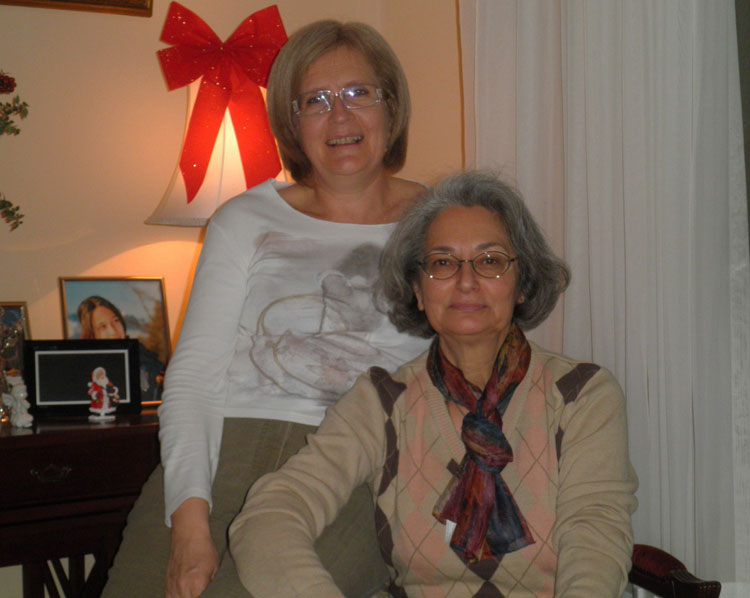 |
